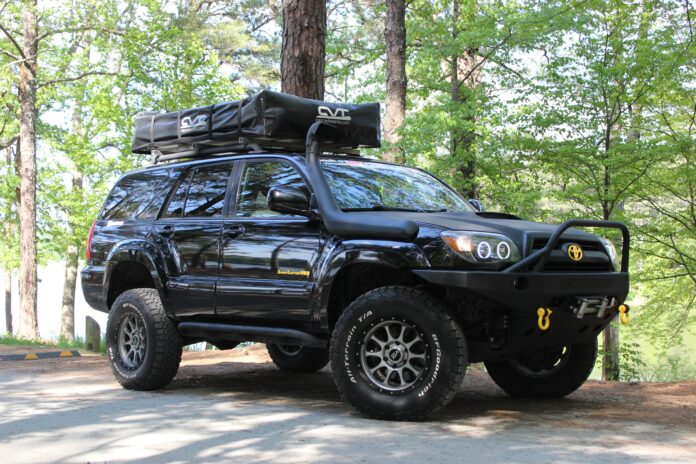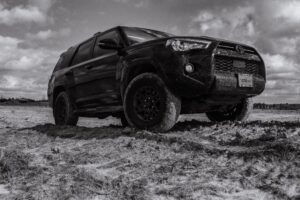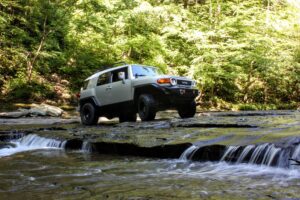
No showroom vehicle is perfect for serious off-road adventures, so you will likely need to modify your car depending on your destination. Before making any modification, however, you should know why you are doing it, what you hope to gain, and what effects it will have on your vehicle.
Here are a few things you should consider before modifying your off-road vehicle.
Install a Lighter Roof Rack.
Off-roaders prioritize roof racks since they can store several items needed for a trip without road accidents. Consider the possibility of how tempted you may be to utilize the Toyota 4runner roof rack fully. With a large roof rack, you can easily pack fuel cans, storage boxes, a spare tire, an awning, even a kitchen sink. All that weight is no good when it comes to an emergency maneuver.
A vehicle with a heavily packed roof rack will take some damage after leaning into an overhanging tree or rock face, while several other cars with less load will breeze by. Moreover, all that wind resistance up top negatively affects your fuel economy and highway driving manners.
To lower the center of gravity, you need to avoid putting too much weight on the roof. You can use lightweight roof racks instead of heavy ones and only haul a few lighter items on them. Good off-road vehicles have the capability of storing the bulk of your gear at the back rig.
Get The Right Tire Size.
It is tricky here in that you cannot have tires that are too small or too big. In addition to carrying the vehicle’s weight poorly, undersized tires may be unable to manage most terrains easily.
Meanwhile, larger tires are weightier, so they will add weight to your vehicle, reducing mileage, straining the engine, and causing axle problems. There is no significant ground clearance difference between 33″ and 35″ tires, and that amount decreases more as air pressure drops.
Make sure you match your steering and suspension components to enable you to safely drive highway speeds and still make emergency maneuvers if you need 37 inches tires for your adventure.
Pick durable tires that are high quality, with strong sidewalls and a tread pattern suitable for the terrain without oversizing or under-sizing them. Tires provide ground clearance, not suspensions. Make sure you have the right size of tires. Additionally, for improved puncture and skid resistance, change from road tires to all-terrain tires with better traction on loose surfaces.
Mount a Skid Plate.
You can’t overlook a skid plate if you are a severe off-roader or intend to be. A skid plate is a metal sheet mounted under a vehicle to protect its undercarriage components against damage from obstacles in the tracks.
It protects the underside of your vehicle, such as the fuel tank, differential, and transfer case, as well as the radiator, engine oil pan, and drivetrain. These plates are handy for off-road vehicles and low ground clearance. Cars with low suspension can utilize skid plates when driving over speed bumps or requiring better aerodynamics.
Implement a Built-in Recovery Point.
You want to avoid one thing at all costs: exploring a new trail or heading to a remote campsite and getting stuck. But this is inevitable for off-roaders. With the installation of bolt-on recovery points to your vehicle, it becomes capable of towing or recovering other cars and even your own.
This is useful when your vehicle becomes stuck. Luckily off-roading is a group activity, which means another car will be at your aid to help pull you out. Whenever you establish a recovery point, take care not to set it at a weak point.
It’s common to see off-road vehicles equipped with two recovery points. Even though two issues aren’t necessary, you can do that to avoid the problem of a single point being inaccessible. The second side will be helpful if the first is broken or buried in mud. You can make the line-pull as straight as possible by choosing from the two points, which one allows you better contact and angle.
Raise Your vehicle.
The right set of tires and high ground clearance make off-road travel easier. Lift kits increase ground clearance, making it possible for vehicles to tackle more enormous obstacles without bottoming out and reducing wear on the skid plate.
You may choose between body lift kits or suspension lift kits. You can install your tires higher with the help of a lift kit, but that may not increase its ground clearance. However, suspension lift kits lift the suspension of a vehicle by replacing the springs and shocks. An all-around lift of three to six inches is suitable for most types of vehicles and especially off-roading. Three-inch lifts offer the additional off-road capability and on-road driveability without requiring extensive modifications.
Takeaways
The truth is, even if stock 4X4 and trucks are capable off the assembly line, a few more modifications can transform them into off-road machines. When you drive off-road, it’s hard to predict what you’ll encounter, but a safety-focused attitude will keep you on track. An excellent off-road vehicle requires a lot of work. To make the most of change, you need to balance all your needs. Ensure your car has reasonable ground clearance and angles. Lastly, don’t trivialize any minor detail; even quality tires can go a long way in off-roading.



















